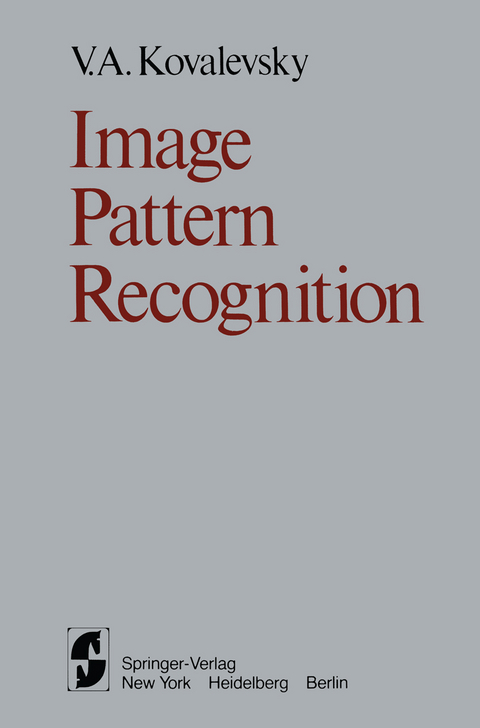
Image Pattern Recognition
Springer-Verlag New York Inc.
978-1-4612-6035-6 (ISBN)
I The Current State of the Recognition Problem.- 1.1 Basic Concepts and Terminology.- 1.2 Heuristic Paths.- 1.3 Methods Based on Assumptions on the Family of Decision Functions.- 1.4 Methods Based on Assumptions about the Properties of the Signals.- 1.5 Applications and Results.- 1.6 Conclusions.- II A Parametric Model of the Image-Generating Process.- 2.1 Difficulties in Image Recognition.- 2.2 A Parametric Model with Additive Noise.- 2.3 The General Parametric Model.- 2.4 Recognition and Learning Viewed as Problems of Optimal Decision with Respect to Parameter Values.- 2.5 Recognition in the Absence of Nuisance Parameters.- 2.6 Recognition with Nuisance Parameters.- 2.7 Optimization of the Decision Rule over a Prescribed Class.- 2.8 Learning and Self-Learning.- 2.9 Problems with Nonstatistical Criteria.- 2.10 Conclusions.- III The Parametric Learning Problem.- 3.1 Learning with a Sample of Mutually Dependent Signals in the Presence of a Nuisance Parameter.- 3.2 Learning with Independent Nuisance Parameters.- 3.3 Learning as the Minimization of the Conditional Risk.- 3.4 Conclusions.- IV On the Criteria for the Information Content of a System of Features.- 4.1 On the Choice of Primary and Secondary Features.- 4.2 Sufficient Statistics.- 4.3 A Measure of Insufficiency.- 4.4 Generalization of the Measure of Insufficiency to the Case of Probabilistic Transformations.- 4.5 Entropy as a Measure of Insufficiency.- 4.6 On the Kullback Divergence.- 4.7 Entropy and Error Probability.- 4.8 The Information Content of the Optimal Decision.- 4.9 Theorems on the Relation between the Conditional Entropy and the Error Probability.- 4.10 Conclusions.- V The Method of Admissible Transformations.- 5.1 Sets that are Closed under Transformations.- 5.2 Admissible Transformations and the Formalization of the Notion of “Similarity”.- 5.3 Peculiarities of the Method of Admissible Transformations.- 5.4 Recognition by the Correlation Method.- 5.5 Experimental Results.- 5.6 Potential Applications of the Correlation Method.- 5.7 Conclusions.- VI Optimization of the Parameters of a Piecewise Linear Decision Rule.- 6.1 The Adequacy of a Piecewise Linear Rule and Formulation of the Optimization Problem.- 6.2 The Linear Decision Rule as a Special Case.- 6.3 The Optimization Problem and Its Solution.- 6.4 Solution of the Optimization Problem for a Piecewise Linear Rule.- 6.5 An Application to the Recognition of Alphanumeric Characters by a Character Reader.- 6.6 Conclusions.- VII The Reference-Sequence Method.- 7.1 Formal Statement of the Structural-Description Problem.- 7.2 Formal Syntactical Rules for Constructing Composite Images.- 7.3 Solution of the Problem of Maximum Similarity.- 7.4 Images on a Two-Dimensional Retina.- 7.5 Recognition of Lines with Restricted Change of Direction.- 7.6 Recognition of Handwritten Characters.- 7.7 Conclusions.- VIII The Recognition of Sequences of Images.- 8.1 Mathematical Model of a Typewritten Line, and Formulation of the Problem.- 8.2 Solution of the Problem.- 8.3 Solution of the Problem with a Correlation Criterion for the Similarity.- 8.4 Recognition of Sequences of Unbounded Length.- 8.5 Examples and Experiments.- 8.6 Scope of the Algorithm and Possible Generalizations.- 8.7 Conclusions.- IX The “?ARS” Character Reader.- 9.1 The Operational Algorithm for a Character Reader.- 9.2 The Technical Implementation of the Line Recognition Algorithm.- 9.3 The Choice of the Hardware for Finding and Scanning the Lines.- 9.4 Block Diagram of the ?ARS Reader.- 9.5 Tests of the Reader.- 9.6 Conclusions. On the Use of CharacterReaders.- References.- List of Basic Notations.
| Übersetzer | A. Brown |
|---|---|
| Zusatzinfo | 241 p. |
| Verlagsort | New York, NY |
| Sprache | englisch |
| Maße | 155 x 235 mm |
| Themenwelt | Informatik ► Grafik / Design ► Digitale Bildverarbeitung |
| Informatik ► Theorie / Studium ► Künstliche Intelligenz / Robotik | |
| Schlagworte | Mustererkennung |
| ISBN-10 | 1-4612-6035-3 / 1461260353 |
| ISBN-13 | 978-1-4612-6035-6 / 9781461260356 |
| Zustand | Neuware |
| Haben Sie eine Frage zum Produkt? |
aus dem Bereich


